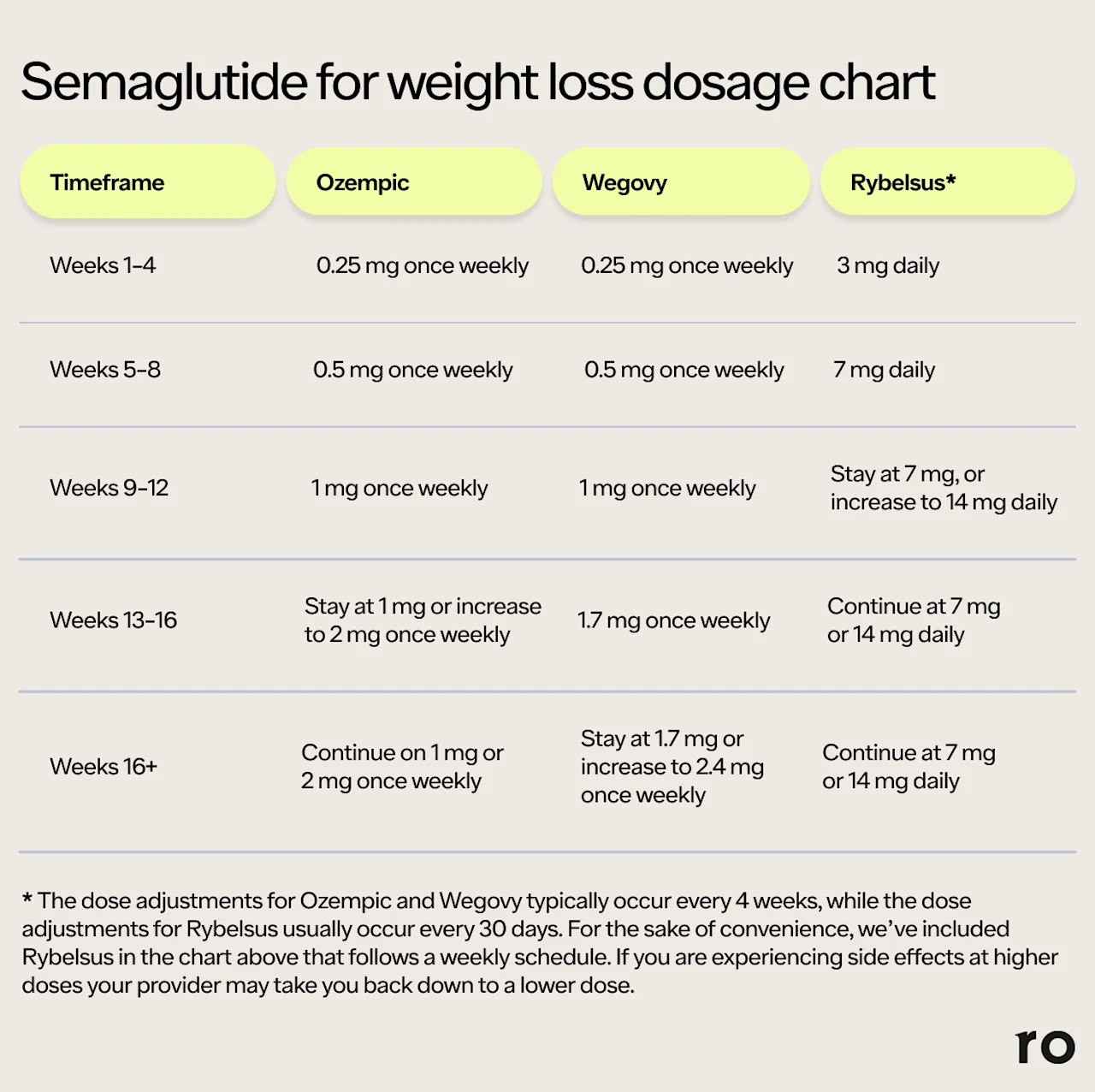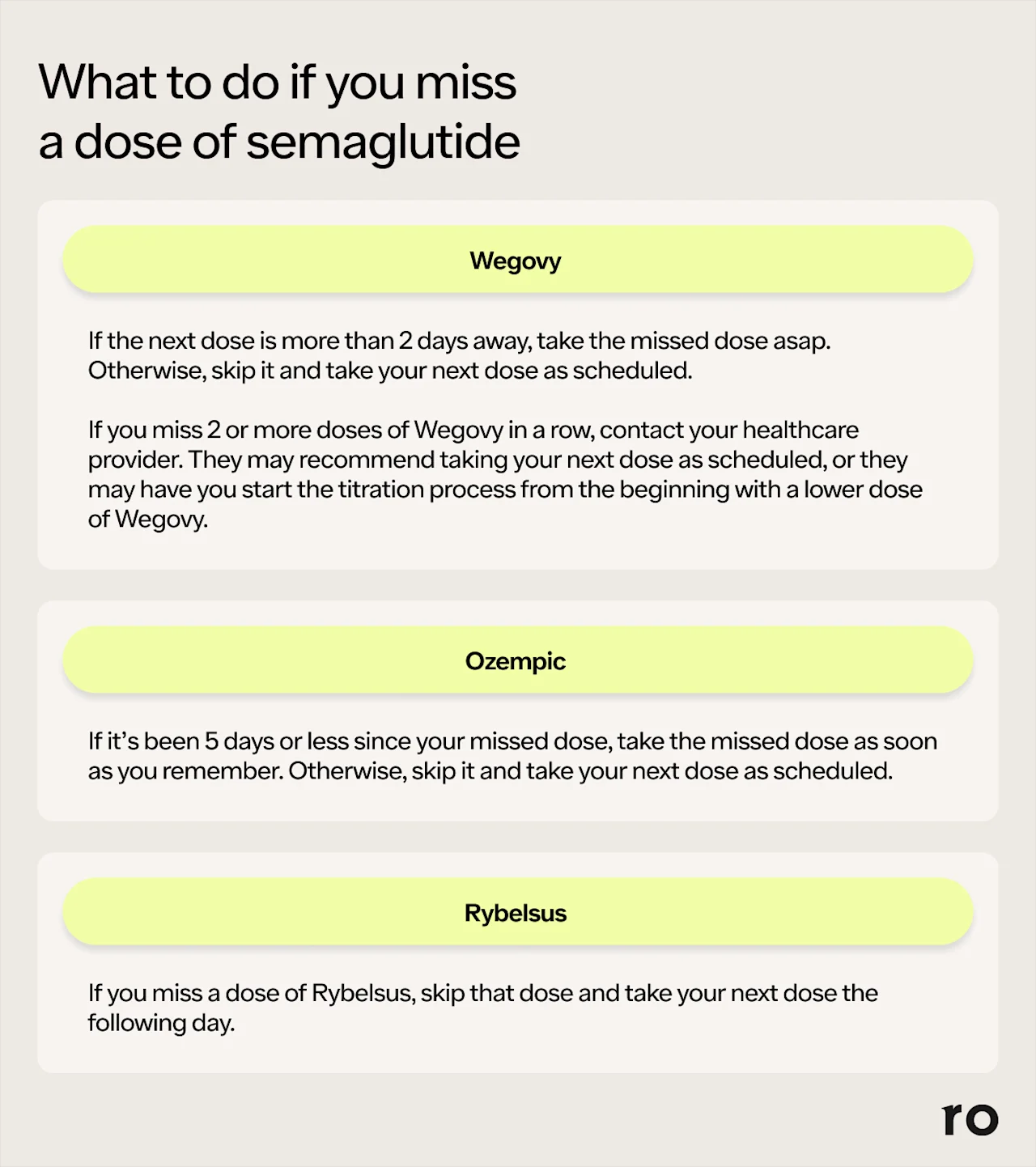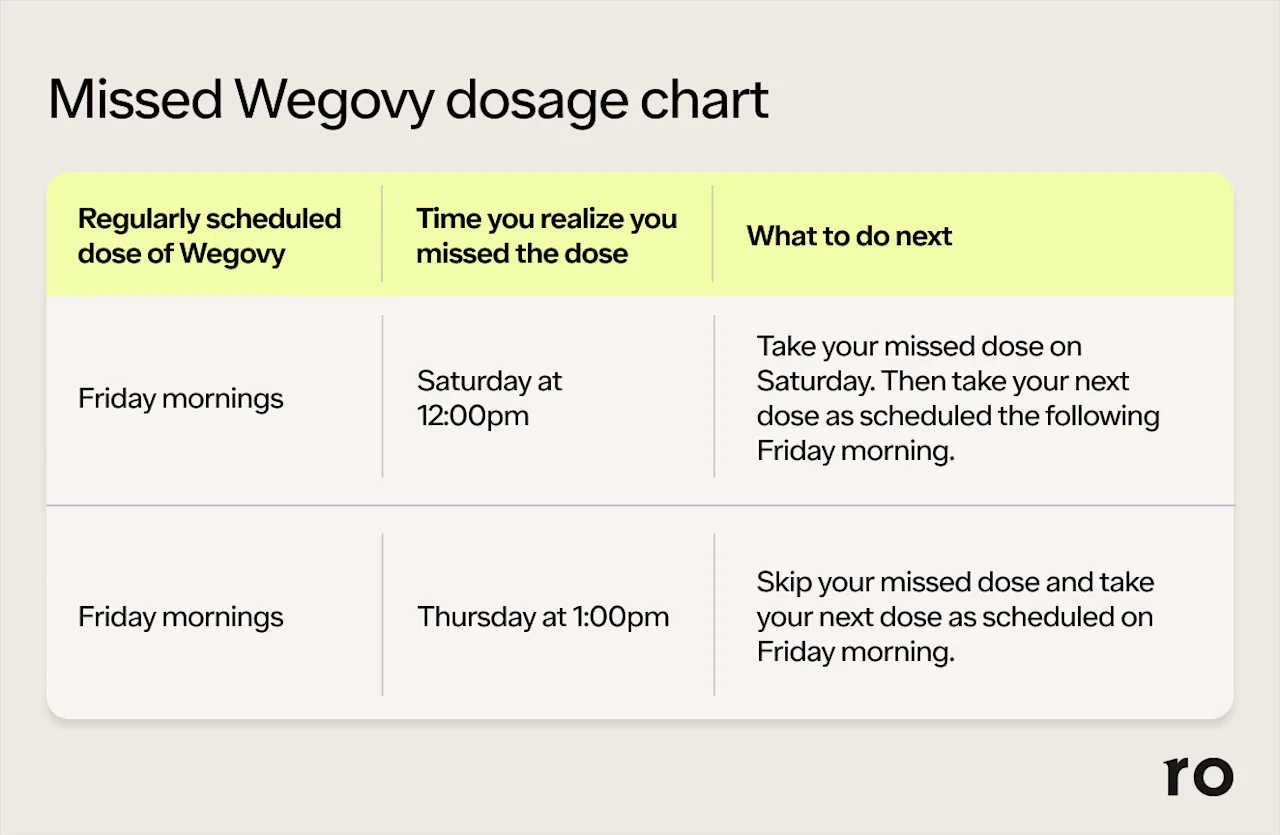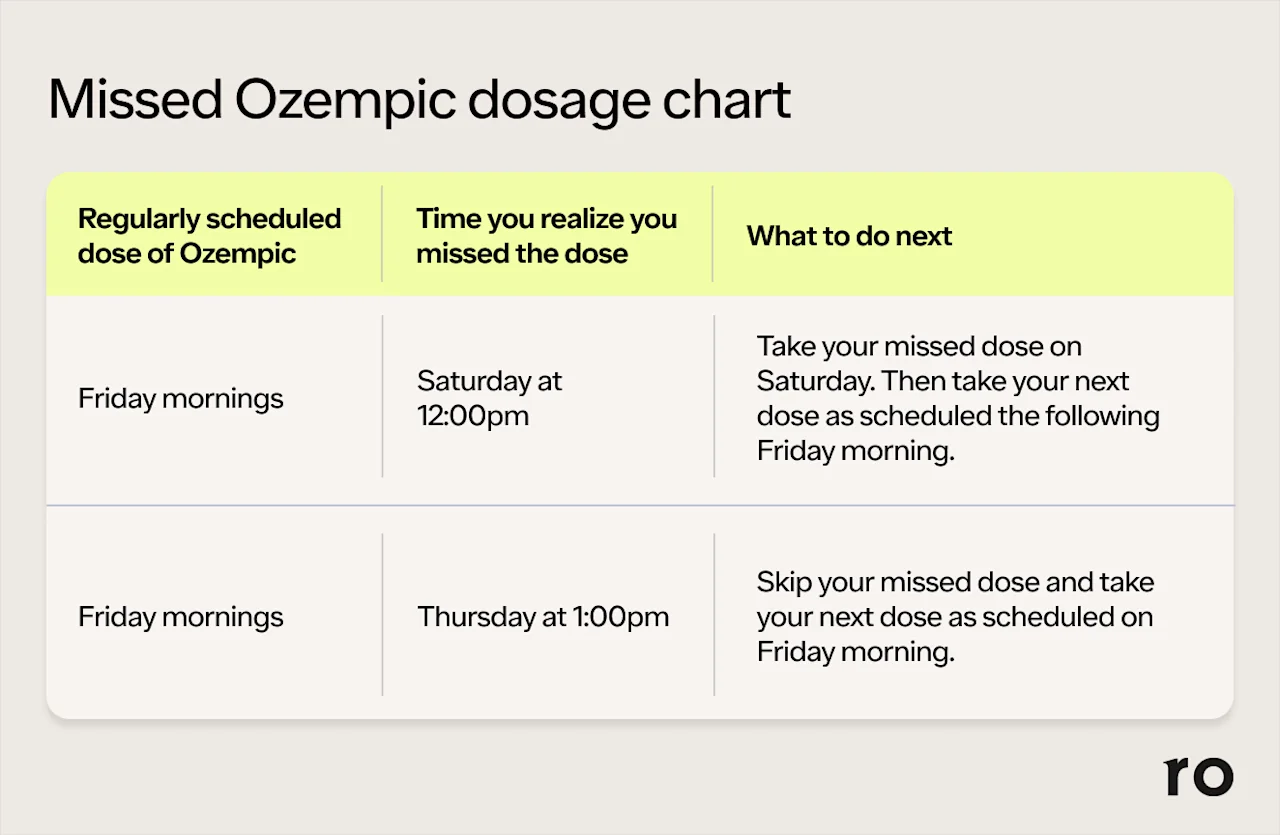Key takeaways
The FDA-approved starting dose of semaglutide for weight loss is 0.25 mg weekly, and the maximum dose of semaglutide for weight loss is 2.4 mg weekly.
Semaglutide dosing follows a ramp-up schedule, as outlined in the semaglutide dosage chart below. It can take up to 16 weeks or more to reach your maintenance dose.
Here's what we'll cover
Key takeaways
The FDA-approved starting dose of semaglutide for weight loss is 0.25 mg weekly, and the maximum dose of semaglutide for weight loss is 2.4 mg weekly.
Semaglutide dosing follows a ramp-up schedule, as outlined in the semaglutide dosage chart below. It can take up to 16 weeks or more to reach your maintenance dose.
Semaglutide, the active ingredient in drugs like Ozempic and Wegovy, produces an average weight loss of 15% over the course of a year and a half.
How much is the semaglutide starting dose for weight loss, and what’s the maximum dose of semaglutide you can take? The semaglutide dose that has been approved by FDA for weight loss usually ranges from 0.25 mg weekly (a typical starting dose) up to 2.4 mg, though it may shift according to your provider and experience with the medication.
Read on as we answer these questions and more. We will also share a semaglutide weight loss dosage chart that breaks this all down at a quick glance, so you can easily reference the dosing schedule.
Semaglutide for weight loss
Semaglutide is the active ingredient in the brand-name drugs Ozempic, Wegovy, and Rybelsus and in compounded semaglutide. Ozempic and Wegovy are once-weekly injectable medications, while Rybelsus is a daily oral medication. Compounded semaglutide can come in different formulations, as it is customized by a compounding pharmacy to meet the needs of an individual patient. Compounded medications not FDA-approved and does not undergo FDA review for safety, effectiveness, or manufacturing. They may be prescribed when a patient’s needs cannot be met by a commercially available drug or during shortages.
Ozempic and Rybelsus are both approved by the US Food and Drug Administration (FDA) to treat adults with type 2 diabetes by controlling blood sugar levels. Wegovy is FDA-approved for chronic weight management in adults with obesity or with overweight and a weight-related health condition (e.g. high blood pressure, type 2 diabetes). Additionally, Ozempic and Wegovy are approved to treat heart disease in people with established heart disease who also have type 2 diabetes (Ozempic) or excess weight (Wegovy).
While Ozempic is not FDA-approved specifically for weight management, it may be prescribed off-label for weight loss. In this article, we’ll focus on the three types of semaglutide typically prescribed for weight loss: the injectable medications Ozempic, Wegovy, and compounded semaglutide.
Semaglutide works for weight loss by slowing down digestion, controlling the release of insulin and glucagon after you eat, and sending signals to your brain that enhance feelings of fullness and reduce your cravings for certain foods. Together, these effects lower your appetite and lead to weight loss.
Semaglutide dosage chart for weight loss
It can take several weeks to months to reach your maintenance dosage of semaglutide for weight loss. The semaglutide dosage chart below offers a quick look at the typical dosing schedule for weight loss.

Semaglutide dose for weight loss
Semaglutide dosing for weight loss follows a process called titration, which is a fancy word that means your dose is gradually increased over time until you reach an effective maintenance dosage.
The FDA-approved starting dose of injectable semaglutide for weight loss is 0.25 mg once weekly. Then, your healthcare provider will guide you through the process, advising you when to increase your dose and to what dosage. Typically, your healthcare provider will have you increase the dosage every four weeks, until you reach a dose that is effective for you while keeping side effects manageable. This is called your maintenance dosage. The maximum dose of semaglutide is 2 mg weekly for Ozempic, and 2.4 mg weekly for Wegovy.
Oral semaglutide (brand name Rybelsus) also follows a titration schedule, but it differs slightly from injectable semaglutide. The starting dose of oral semaglutide is 3 mg daily. After 30 days on the 3 mg dosage, your healthcare provider may have you increase your dosage to 7 mg. If you spend 30 days on the 7 mg dosage and your healthcare provider determines that a higher dosage is needed, they’ll instruct you to increase your dosage to 14 mg daily. This is the maximum dose of Rybelsus.
Compounded semaglutide dose for weight loss
Compounded semaglutide dosing often mirrors that of branded (Ozempic, Wegovy) semaglutide. However, some healthcare providers may choose to prescribe customized doses or dosing schedules based on an individual patient's needs. Providers can do so because compounded semaglutide often comes in vials, which enable the administration of different doses of medication (as opposed to the prefilled pens of Ozempic and Wegovy).
Providers may choose to customize a person's dose of compounded semaglutide for weight loss based on their medical history, side effects, or weight loss goals. Ultimately, any particular patient's treatment plan for compounded semaglutide—not unlike a titration schedule for branded medication—is up to the discretion of their provider.
How to take semaglutide for weight loss
Semaglutide is injected subcutaneously, which means under the skin. So, to take semaglutide for weight loss, you’ll need to give yourself a shot. Don’t worry; the needles on the injection pens are so thin and short that they won’t go very deep.
There are three recommended spots for injecting semaglutide: the upper arm, thigh, or abdomen (around or below your belly button). You’ll rotate through the sites each week to give the skin time to heal between semaglutide injections.
How you take semaglutide for weight loss can vary slightly depending on if you are taking Wegovy, Ozempic, or compounded semaglutide. Here are the key differences:
Wegovy: Each dose of Wegovy comes in its own prefilled, single-dose pen with a needle attached. So, you can inject Wegovy and dispose of the pen in a sharps container afterward.
Ozempic: Ozempic pens, on the other hand, contain 4–6 doses in a single pen. Each time you use your Ozempic pen, you’ll need to attach a NovoFine Plus needle and select your dose using the dial on the pen.
Compounded semaglutide: Compounded semaglutide typically comes in glass vials, so you’ll likely need to prepare your own dose of semaglutide each week by drawing the liquid into the syringe.
Read on for a step-by-step to taking semaglutide.
How to inject semaglutide for weight loss
How to inject semaglutide for weight loss depends on whether you’re taking Ozempic, Wegovy, or compounded semaglutide. Below, we share step-by-step instructions for injecting semaglutide, noting the differences for each medication. Always review the injection instructions included with your package of semaglutide.
Clean your hands. Wash your hands with soap and water and dry them with a clean towel.
Gather all of your supplies. This includes:
Your Ozempic or Wegovy pen or your vial of compounded semaglutide
Gauze pad, cotton ball, or alcohol swabs to clean the injection site
A new sterile needle (Ozempic only)
A sterile syringe (compounded semaglutide only)
Your sharps disposal container
Ensure the medication looks safe to use. Double-check the information on the prescription vial or pen, including the dose amount and expiration date. The medication should be clear and colorless. If it’s cloudy, discolored, or contains particles, do not use it and contact your pharmacist. Air bubbles are okay. If you’re injecting Wegovy, skip ahead to step 6 after you’ve performed this step.
Prepare the needle (Ozempic and compounded semaglutide only). Attach a new needle to your pen, if you’re injecting Ozempic, or remove the caps from the plunger and the needle, if you’re injecting compounded semaglutide. Always use a new needle for each injection to prevent contamination.
Select your dose of semaglutide (Ozempic and compounded semaglutide only).
If you’re injecting Ozempic, turn the dose selector until your prescribed dose appears. If this is your first time using the Ozempic pen, check the Ozempic flow first by turning the dose selector until you see the flow check symbol. Then hold the pen upright with the needle pointing up, and press and hold the dose button until the counter shows “0.” A drop of medicine should appear at the tip. Then turn the dose selector until your prescribed dose appears.
If you’re injecting compounded semaglutide, fill the syringe by pulling the plunger down to the correct dose and inserting the needle into the rubber part of the vial. Press down on the plunger, and with the needle still in the vial, turn the vial upside down. Then pull the plunger past your dose amount, tap the syringe to remove any air bubbles, and push the plunger back to your prescribed dose level. Turn the vial upright again and remove the needle.
Choose an injection site. It can be your abdomen, thigh, or the back of your upper arm. Clean the area with soap and water or an alcohol swab. Let it dry.
Inject your dose of semaglutide firmly into your skin at a 90-degree angle.
If you’re injecting Ozempic, press down on the dose button and hold until the counter shows “0,” then keep it pressed while you count to six before removing the needle.
If you’re injecting Wegovy, keep applying pressure until the yellow bar stops moving (you’ll hear two clicks during the injection, which should last 5–10 seconds total).
If you’re injecting compounded semaglutide, pinch and hold the skin that you’ll inject. Then quickly push the needle through the skin, making sure to insert the entire length of the needle. Slowly push the plunger to inject all of the medication.
Remove the needle from your skin. If you see any blood at the injection site, lightly press it with a gauze pad or cotton ball. Don’t rub the area.
Safely dispose of the Wegovy pen or any used needles or syringes in a FDA-cleared sharps disposal container. If your Ozempic pen or compounded semaglutide vial still contains more doses, store them according to the instructions included with your medication. Ozempic pens can be stored at room temperature (59°F to 86°F or 15°C to 30°C) or in a refrigerator (36°F to 46°F or 2°C to 8°C), away from direct sunlight, for up to 56 days. Never throw away any needles or syringes in your household trash.
If you are taking compounded semaglutide that comes in a vial, here’s a handy guide to help you inject your medication:
What to do if you miss a dose of semaglutide for weight loss
Ideally, you’d never skip a dose of Wegovy or Ozempic. But sometimes life gets in the way. If you miss a dose of semaglutide for weight loss, your next steps will depend on how long it’s been since the date of your missed dose and the specific medication you’re taking. For instructions, review the insert that comes with your carton of semaglutide. These guidelines for missed doses are designed to prevent you from having too much semaglutide in your system, which can increase your risk of side effects.
Semaglutide in injection forms follows a weekly dosing schedule, which can make it more challenging to remember to take your dose than with a daily medication. To avoid missing a dose of semaglutide for weight loss, try these tips:
Set a reminder on your phone using your calendar or reminder app.
Write it down in your planner or wall calendar.
Coordinate your semaglutide dose with other weekly activities you never miss, such as a work meeting or religious service.
Missed semaglutide dosage chart
If you miss a dose of semaglutide, your next steps depend on the medication you’re taking. Here’s what to do if you miss a dose of semaglutide.

Missed Wegovy dosage chart
If you miss a dose of Wegovy and your next dose is more than 2 days (48 hours) away, take your missed dose as soon as you remember. If your next dose is less than 2 days away (48 hours) away, skip the missed dose altogether and take your next dose on the regularly scheduled day. If you miss 2 or more doses of Wegovy in a row, contact your healthcare provider. They may recommend taking your next dose as scheduled, or they may have you start the titration process from the beginning with a lower dose of Wegovy.
Here’s an example of how your missed Wegovy dose may work:

Missed Ozempic dosage chart
If it’s been 5 days or less since your missed dose of Ozempic, take the missed dose as soon as you remember. If more than 5 days have passed, skip the missed dose altogether and take your next dose on the regularly scheduled day.
Here’s an example of how your missed Ozempic dose may work:

Missed Rybelsus dosage chart
If you miss a dose of Rybelsus, skip that dose and take your next dose the following day.
Here’s an example of how your missed Rybelsus dose may work:

Side effects of semaglutide for weight loss
Semaglutide is a type of medication known as GLP-1 receptor agonist. These drugs are known for causing digestive side effects such as:
Nausea
Vomiting
Diarrhea
Abdominal pain
Constipation
The above are the most common side effects of Ozempic. Wegovy may also cause side effects, such as:
Headache
Fatigue
Indigestion
Heartburn (gastroesophageal reflux disease)
Dizziness
Bloating
Belching
Flatulence
Low blood sugar (hypoglycemia) in people with type 2 diabetes
Some of these effects are more common than others. Some people may also experience mild irritation or discomfort at the spot where they inject semaglutide. A majority of the digestive side effects of semaglutide tend to be most frequent and intense at the beginning of treatment or during dose escalation. They tend to go away with time as your body gets used to the medication.
In less common cases, semaglutide may be linked to more serious side effects. These include:
Inflammation of the pancreas (pancreatitis)
Worsening diabetic retinopathy if you already have it (vision changes or loss in people with type 2 diabetes, especially those who already have diabetic retinopathy)
Kidney or gallbladder problems
Serious allergic reaction
Fast heartbeat (tachycardia)
What to do if you have significant side effects of semaglutide for weight loss
Some people may experience significant gastrointestinal side effects on semaglutide—including nausea, vomiting, and diarrhea—especially on higher doses. In clinical trials of Wegovy, this has led 4% to 17% of people to stop taking semaglutide for weight loss. Further research has found that these rates may be even higher in the real world, especially for people with obesity taking semaglutide or other GLP-1s for weight loss.
If you are experiencing significant gastrointestinal distress on semaglutide, contact your healthcare provider. They may suggest a number of things to ease your distress, depending on your symptoms. For example, eating more slowly, avoiding fatty foods, and increasing your water intake can help relieve nausea and vomiting. Increasing your physical activity and eating more fiber can help with constipation. There are also specific medications that can be prescribed to help you decrease nausea.
If your side effects do not improve, your healthcare provider may suggest lowering your dose of semaglutide to see if that eases them. Another option may be to switch to another GLP-1 medication or try alternative weight loss treatment such as tirzepatide.
Bottom line
The semaglutide dose for weight loss can vary depending on whether you are taking Ozempic, Wegovy, or compounded semaglutide. Whichever medication you are taking, your healthcare provider will likely have you start with a low dose, before slowly increasing your dose over a period of weeks to months until you reach an effective maintenance dose.
Semaglutide follows a gradual titration schedule for weight loss. For injectable semaglutide, doses start at 0.25 mg per week and may increase to a maximum of 2 mg (Ozempic) or 2.4 mg (Wegovy) weekly. For oral semaglutide (Rybelsus), doses start at 3 mg daily and increase to a maximum of 14 mg. Depending on the medication, it can take up to 16 weeks to reach your maintenance dosage of semaglutide.
Different forms of semaglutide have different methods of administration. Wegovy comes in single-use pens, while Ozempic pens contain multiple doses. Compounded semaglutide typically comes in vials and requires manual preparation. Rybelsus is a daily oral medication.
If you miss a dose of semaglutide for weight loss, next steps depend on the medication. People taking Ozempic should take their missed dose as soon as they remember, if it's been 5 days or less since the missed dose. People taking Wegovy should take their missed dose as soon as they remember if their next dose is more than 2 days away. Those taking Rybelsus can simply resume their dosing schedule the following day.
Side effects are common when taking semaglutide. It’s important to communicate regularly with your healthcare provider when you begin semaglutide treatment. If side effects become too much, they can lower your dose of semaglutide or recommend other ways to ease side effects.
DISCLAIMER
If you have any medical questions or concerns, please talk to your healthcare provider. The articles on Health Guide are underpinned by peer-reviewed research and information drawn from medical societies and governmental agencies. However, they are not a substitute for professional medical advice, diagnosis, or treatment.
Ozempic Important Safety Information: Read more about serious warnings and safety info.
Wegovy Important Safety Information: Read more about serious warnings and safety info.
References
Do, D., Lee, T., Peasah, S. K., et al. (2024). GLP-1 receptor agonist discontinuation among patients with obesity and/or type 2 diabetes. JAMA Network Open, 7(5), e2413172. doi: 10.1001/jamanetworkopen.2024.13172. Retrieved from https://jamanetwork.com/journals/jamanetworkopen/fullarticle/2819256
Gorgojo-Martínez, J. J., Mezquita-Raya, P., Carretero-Gómez, J., et al. (2022). Clinical Recommendations to Manage Gastrointestinal Adverse Events in Patients Treated with Glp-1 Receptor Agonists: A Multidisciplinary Expert Consensus. Journal of Clinical Medicine, 12(1), 145. doi: 10.3390/jcm12010145. Retrieved from https://pmc.ncbi.nlm.nih.gov/articles/PMC9821052/
Kommu, S. & Whitfield, P. (2024). Semaglutide. StatPearls. Retrieved from https://www.ncbi.nlm.nih.gov/books/NBK603723/
Novo Nordisk-a. (2024). Ozempic (semaglutide) injection is available in 3 multiuse pens for more A1C control. Retrieved from https://www.novomedlink.com/diabetes/products/treatments/ozempic/dosing-administration/ozempic-pen.html
Novo Nordisk-b. (2024). Talking to your patients about Ozempic (semaglutide) injection. Retrieved from https://www.novomedlink.com/diabetes/products/treatments/ozempic/resources/for-pharmacists.html
Shu, Y., He, X., Wu, P., et al. (2022). Gastrointestinal adverse events associated with semaglutide: A pharmacovigilance study based on FDA adverse event reporting system. Frontiers in Public Health, 10, 996179. doi: 10.3389/fpubh.2022.996179. Retrieved from https://www.ncbi.nlm.nih.gov/pmc/articles/PMC9631444/
U.S. Food and Drug Administration (FDA). (2023). Highlights of Prescribing Label: Ozempic (semaglutide) injection, for subcutaneous use. Retrieved from https://www.accessdata.fda.gov/drugsatfda_docs/label/2023/209637s020s021lbl.pdf
U.S. Food and Drug Administration (FDA-a). (2024). Highlights of Prescribing Label: Rybelsus (semaglutide) tablets, for oral use. Retrieved from https://www.accessdata.fda.gov/drugsatfda_docs/label/2024/213051s018lbl.pdf
U.S. Food and Drug Administration (FDA-b). (2024). Highlights of Prescribing Label: Wegovy (semaglutide) injection, for subcutaneous use. Retrieved from https://www.accessdata.fda.gov/drugsatfda_docs/label/2024/215256s011lbl.pdf
Wilding, J. P., Batterham, R. L., Calanna, S., et al. (2021). Once-Weekly Semaglutide in Adults with Overweight or Obesity. New England Journal of Medicine, 384(11), 989–1002. doi: 10.1056/nejmoa2032183. Retrieved from https://www.nejm.org/doi/full/10.1056/NEJMoa2032183














